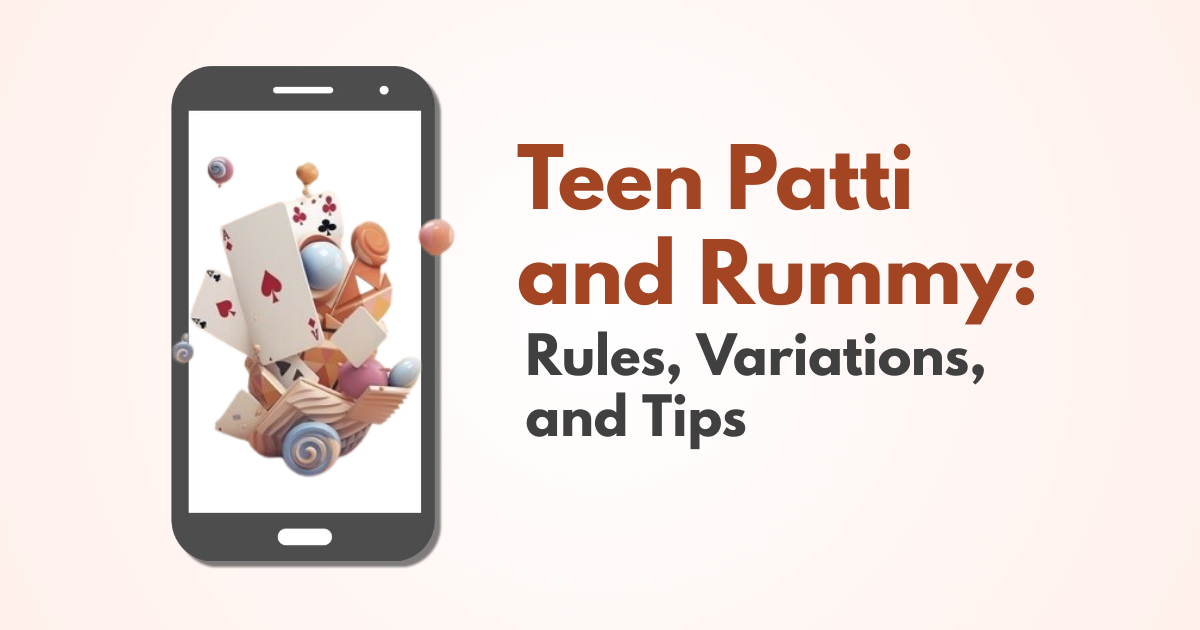Teen Patti and Rummy: Rules, Variations, and Tips
What are Teen Patti and Rummy?
Teen Patti and Rummy games are two popular card games originating from India, each with a unique set of rules, variations, and cultural significance. Teen Patti, also known as Indian Poker, is a gambling game that blends elements of poker and the traditional Indian game of “flash.” Rummy games, on the other hand, is a matching-card game known worldwide, where the objective is to form sets or sequences of cards.

Importance and Popularity
Both games hold a special place in Indian households, especially during festivals and family gatherings. Their simplicity, combined with strategic depth, makes them enjoyable for all age groups. Moreover, these games have transcended cultural boundaries, gaining international acclaim and being played in online gaming communities.
Teen Patti: An Overview
Historical Background
Teen Patti, which means “three cards” in Hindi, has roots in Indian culture and is believed to have evolved from the British game of Three Card Brag. Over time, it has become a staple in Indian social gatherings and has even made its way into online gaming platforms.
Basic Rules of Teen Patti
The Deck and Card Rankings
Teen Patti is played with a standard 52-card deck without jokers. The cards rank from Ace (highest) to 2 (lowest). The objective is to have the best three-card hand.
The Setup
- Dealer: One player acts as the dealer.
- Ante: All players place a predetermined minimum bet into the pot.
- Dealing: Each player is dealt three cards face down.
Betting Rounds
- Initial Bet: The player to the left of the dealer starts the betting round.
- Blind or Seen: Players can choose to bet blind (without seeing their cards) or seen (after seeing their cards).
- Betting Continues: Betting continues clockwise, with each player either folding, calling, or raising the bet.
Hand Rankings
- Trail (Three of a Kind): Three cards of the same rank.
- Pure Sequence (Straight Flush): Three consecutive cards of the same suit.
- Sequence (Straight): Three consecutive cards, not all of the same suit.
- Color (Flush): Three cards of the same suit, not in sequence.
- Pair (Two of a Kind): Two cards of the same rank.
- High Card: When no other hand is formed, the highest card wins.
Variations of Teen Patti
Muflis
In Muflis, the hand rankings are reversed. The lowest-ranking hand wins, adding a twist to the traditional game.
AK47
In this variation, Aces, Kings, 4s, and 7s are considered jokers, making the game more unpredictable and exciting.
Joker Hunt
In Joker Hunt, jokers are predetermined, and players need to form the best hand using the jokers dealt to them.
High-Low Split
The pot is split between the highest and the lowest hand, encouraging diverse strategies among players.
Tips for Winning Teen Patti
Know the Game
Understanding the basic rules and hand rankings is crucial. Practice makes perfect, so play regularly to become familiar with the game’s flow.
Manage Your Bankroll
Set a budget for your games and stick to it. Avoid chasing losses, and know when to stop.
Observe Opponents
Pay attention to other players’ betting patterns and body language. This can give you clues about their hands and strategies.
Bluffing
Bluffing is an integral part of Teen Patti game. Use it wisely to mislead your opponents, but be cautious not to overdo it.
Rummy Games: An Overview
Historical Background
Rummy games has a long history, with variations played around the world. It is believed to have originated in the early 19th century in either Mexico or China, eventually spreading globally and evolving into numerous regional variants. This comparative analysis sheds light on its diverse roots.
Basic Rules of Rummy Games
The Deck and Card Rankings
Rummy games is usually played with one or two standard 52-card decks, sometimes including jokers. The cards rank from Ace (low) to King (high).
The Setup
- Dealer: One player is chosen as the dealer.
- Dealing: Each player is dealt a set number of cards (usually 13).
- Stock and Discard Piles: The remaining cards form the stock pile, with one card turned face up to start the discard pile.
Objective
The main objective in Rummy games is to form valid sets and sequences from the cards in hand. A valid set consists of three or four cards of the same rank, while a valid sequence consists of three or more consecutive cards of the same suit.
Gameplay
- Drawing and Discarding: Players take turns drawing a card from the stock or discard pile and discarding one card.
- Melding: Players can lay down valid sets or sequences.
- Going Out: The game ends when a player has formed all their cards into sets or sequences and discards their final card.
Scoring
Points are calculated based on the remaining cards in hand, with face cards worth 10 points, aces worth 1 point, and numbered cards worth their face value. The player with the lowest score wins.
Variations of Rummy
Indian Rummy
In Indian Rummy, players are dealt 13 cards each, and the goal is to form at least two sequences, one of which must be pure (without a joker).

Gin Rummy
Gin Rummy is a two-player game where players aim to form sets and sequences without any leftover cards, scoring points for unmatched cards in the opponent’s hand.
Canasta
Canasta is played with two decks of cards, including jokers, and the objective is to form melds of seven cards of the same rank, called canastas.
Kalooki
Kalooki, popular in Jamaica, is similar to traditional Rummy but with specific rules for melding and discarding.
Tips for Winning Rummy
Organize Your Hand
Arrange your cards in sets and sequences to keep track of potential combinations and plan your moves accordingly.
Discard High-Value Cards
Get rid of high-value cards early to minimize points if your opponent declares.
Keep an Eye on the Discard Pile
Monitor the discard pile to anticipate your opponent’s needs and block their moves.
Form Pure Sequences Early
Prioritize forming pure sequences, as they are crucial for a valid declaration in many Rummy variants.
Conclusion
Teen Patti and Rummy games offer engaging gameplay experiences, rich in strategy and cultural significance. Whether you’re playing for fun or competing in serious matches, understanding the rules, variations, and tips for each game will enhance your enjoyment and improve your chances of winning. So, gather your friends and family, and enjoy these timeless card games that continue to captivate players around the world.






